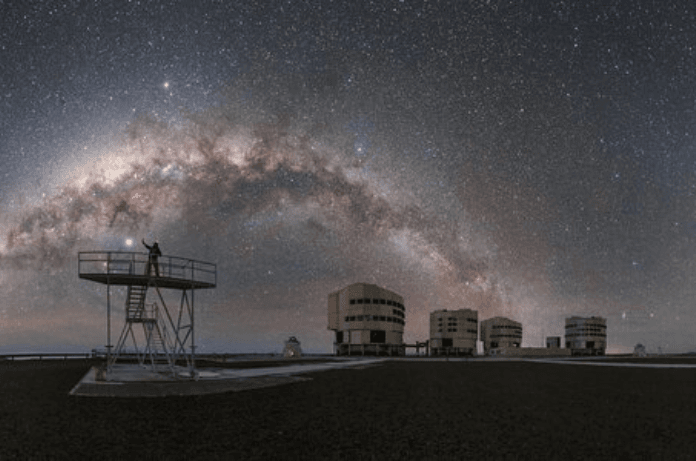In the heart of Chile’s Atacama Desert, where the skies are so dark and clear that distant galaxies can be seen with stunning clarity, lies the Paranal Observatory, one of the world’s most important astronomical research sites. However, this precious window to the universe is now under serious threat. A proposed industrial megaproject by AES Andes, a subsidiary of the US-based AES Corporation, could permanently damage the pristine night skies that make this region ideal for astronomical discoveries.
AES Andes recently submitted plans for an enormous industrial complex spanning over 7,400 acres, comparable in size to the cities of Valparaiso in Chile or Garching in Germany. Planned just 5 to 11 kilometers from Paranal’s telescopes, the project includes a port, ammonia, and hydrogen production plants, and thousands of electricity generation units. If approved, the construction and ongoing operations could introduce light pollution, dust emissions, and atmospheric disturbances, compromising the observatory’s ability to explore the universe.
Astronomers, including ESO’s leadership, are raising urgent concerns, calling for the project’s relocation to safeguard one of Earth’s last truly pristine dark skies. The outcome of this battle could determine the future of astronomical discoveries for generations to come.
Why Paranal Observatory Matters
Since its opening in 1999, Paranal Observatory has been at the forefront of global astronomy. Built and operated by the European Southern Observatory (ESO), it has enabled groundbreaking discoveries, from capturing the first image of an exoplanet to providing key data confirming the accelerated expansion of the universe.
Paranal played a crucial role in the research that won the 2020 Nobel Prize in Physics, which involved studying the supermassive black hole at the center of the Milky Way. These discoveries were made possible by the observatory’s Very Large Telescope (VLT), a powerful array of four telescopes, each with a 27-foot (8.2-meter) mirror, working together to capture some of the sharpest images of the cosmos ever taken.
The Atacama Desert’s exceptional atmospheric stability and absence of light pollution make it an unparalleled location for observing the universe. The region also hosts other major projects, such as the under-construction Extremely Large Telescope (ELT) on Cerro Armazones, which promises to revolutionize our understanding of the cosmos once completed.
However, all of this could be jeopardized if the industrial project moves forward.
How the Industrial Project Threatens Astronomy
The proposed AES Andes project, called Inna, would create an industrial complex on a scale rarely seen near a scientific site of this importance. Spanning more than 7,400 acres, it would feature a port, ammonia, and hydrogen production plants, and thousands of electricity generation units, all within a few kilometers of the observatory.
The primary concerns for astronomers stem from three significant threats:
- Light Pollution: Even minimal artificial light can severely impact the clarity of astronomical observations. The constant illumination from the industrial site would reduce the darkness of the skies, making it harder to detect faint celestial objects.
- Dust and Atmospheric Turbulence: Construction activities and industrial operations would generate dust and heat, affecting the atmospheric stability that makes the Atacama such a perfect observation site. Increased turbulence could blur telescope images, reducing their accuracy.
- Proximity Risks: Being just 5 to 11 kilometers away, the project’s massive scale and operational footprint would directly interfere with Paranal’s ability to conduct sensitive observations.
These risks threaten not only current projects but also multi-billion-Euro investments made by ESO member states and other global research institutions.
A Global Scientific Loss
The Paranal Observatory is not just a Chilean treasure and it serves the entire global scientific community. Its discoveries have expanded our knowledge of the universe, from imaging distant galaxies to studying asteroids in our solar system. In 2021, Paranal captured stunning images of 42 of the solar system’s largest asteroids, and in 2023, it documented the aftermath of NASA’s DART mission, which tested deflecting an asteroid’s orbit.
The observatory has also been critical for studying the evolution of the universe. Recently, its telescopes observed gas clouds believed to have formed after the first stars ignited a discovery that could reshape our understanding of cosmic origins.
However, light pollution is already a growing problem worldwide. A 2022 study revealed that two-thirds of major observatories have seen at least a 10% rise in artificial light over natural levels, showing how vulnerable dark skies have become. Paranal remains one of the last places on Earth with minimal light interference an asset now at serious risk.
Calls to Move the Project to a Different Location
ESO officials and the global astronomy community are urging Chilean authorities to reconsider the project’s location.
“The proximity of the AES Andes industrial megaproject to Paranal poses a critical risk to the most pristine night skies on the planet,” said ESO Director General, Xavier Barcons. “Dust emissions during construction, increased atmospheric turbulence, and especially light pollution will irreparably impact the capabilities for astronomical observation, which have thus far attracted multi-billion-Euro investments by the governments of the ESO Member States.”
ESO’s Representative in Chile, Itziar de Gregorio, echoed these concerns: “Chile, and particularly Paranal, is a truly special place for astronomy—its dark skies are a natural heritage that transcends its borders and benefits all humanity. It is crucial to consider alternative locations for this megaproject that do not endanger one of the world’s most important astronomical treasures.”
Why Relocation Matters
The Atacama Desert’s dark skies are not just a natural wonder, they are vital for the progress of human knowledge. Moving the industrial complex to a different location would protect decades of scientific work, preserve multi-billion-euro investments in astronomical research, and ensure future generations can continue to explore the universe from one of its best observation points.
This is not merely about protecting a single observatory and it’s about safeguarding humanity’s ability to explore the vast, mysterious universe that surrounds us. The choice is clear: relocating the project is the only way to protect the dark skies of Paranal and the incredible discoveries they enable.

